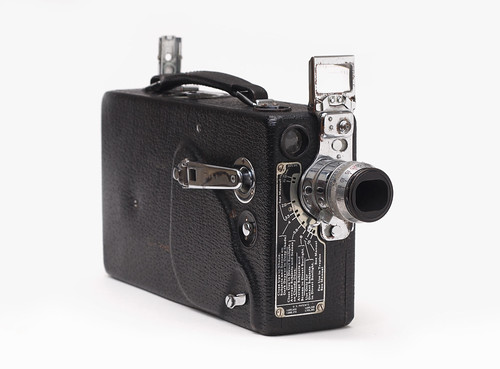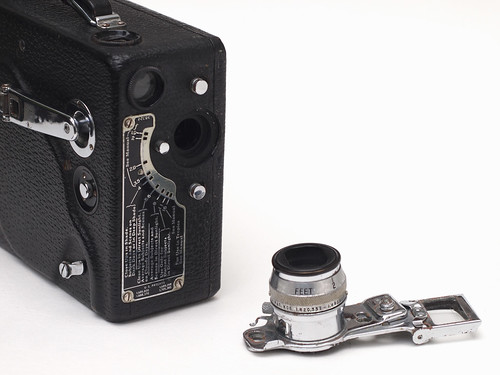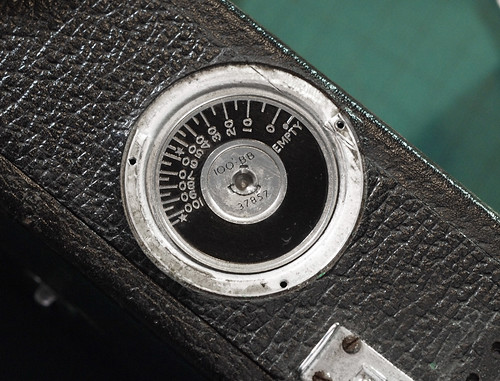 |
| Ciné-Kodak Model K 16mm camera |
A leader for years, Ciné-Kodak, Model K, is deservedly still the favorite 16mm. motion picture camera of thousands of home movie fans. Moderately priced, Model K possesses such outstanding features as 100-foot film capacity, Kodak Anastigmat f/1.9 lens–easily interchangeable with a wide selection of accessory lenses, half speed and normal speed, eye-level and waist-height finder, and locking exposure lever.
Cine-Kodak 8mm and 16mm Home Movie Equipment, 1940
In my post on the
Ciné-Kodak Model BB Junior, I summarised the evolution of Kodak's range of 16mm cine cameras, from the (retrospectively named) Model A, followed by the Model B, which represents a significant design rethink, and then the BB (and its derivative, the BB Junior), taking the general layout of the Model B, but, by using a smaller capacity spool, making the camera smaller and lighter. The next model, introduced in July 1930, was the
Ciné-Kodak Model K. This represented a change in the Kodak ciné cameras' naming conventions, with the previous models named in something approaching a logical sequence. Possibly, the use of the letter 'K' is from Kodak itself, indicating that, when introduced, the Ciné-Kodak Model K was seen as the definitive design iteration of Kodak's 16mm ciné cameras; Kodak manufactured the Model K for 16 years, until 1946, longer than any of the other 16mm models (the next longest production run–15 years–was the Ciné-Kodak Special) and, as a result, ninety years on, the Model K is not a rare camera.
 |
| Ciné-Kodak Model BB Junior (front) and Model K (back) |
Taking the general design and internal layout from the Ciné-Kodak BB, with a slightly longer and taller body, the Model K was designed for the larger-capacity 100ft daylight-loading spool–used in the first two Kodak 16mm cameras–that the BB had sacrificed for compactness. This would mean around 4 minutes of footage at the camera's normal running at 16 frames per second. With aspects of the BB's design, the Model K is smaller than the Model B, but with comparable specifications. After my initial experiences with the Ciné-Kodak BB Junior, I subsequently had an eye on the Model K for its capacity to take daylight-loading 100ft spools, rather than the BB Junior's 50ft spools; apart from the spool size, most of my caveats about contemporary use of the BB Junior apply to the Model K, particularly that it takes double-perforated 16mm film. However, I saw a Model K offered for sale on a well-known auction website for a starting price of just €3.50–from Germany. With postage this was just over £20 in total and no-one else placed a bid on the camera (this was in late 2020, before the UK left the EU, and before prices when buying from the EU went up considerably as a result). The Model K came with the f1.9 25mm Anastigmat lens, which was the higher-priced variant; it could also be bought with a lower-value f3.5 25mm lens. The camera came in its original case, which has space for a second lens, with mounting pins to secure it, and two rolls of film. It also had the key for the case's lock, attached to the ribbon inside.
 |
| Ciné-Kodak Model K in original case |
Other than taking 100ft spools, the main difference from the BB Junior is that the Model K has interchangeable lenses. My version came with the standard 25mm f1.9 anastigmat lens (the Model K could also be bought cheaper with a f3.5 25mm lens); other lenses do show up from time to time, but seem to be rare. As a viewfinder camera, the interchangeable lenses each had a front viewfinder attached to the mount, so changing a lens also changes the viewfinder (the rear sight on the body remains). The Model K also has a waist-level viewfinder on the body, next to the lens, but the angle of view for this is unaffected by changing lenses. There was a wide range of lenses provided for the Model K: by 1940, there were 7 available in additional to the standard 25mm, from a wide-angle 15mm lens to a 152mm/6 inch lens. Early in 1940, Kodak abandoned the aperture plate guide around the lens with descriptions of lighting conditions and subjects as by then there was a wider range of film stocks available with a range of speeds, thus making too many exceptions; my camera evidently dates from before this, and did not later have its aperture plate replaced, as was offered as a service (it does intriguingly have two marks in the leather on one side which look as though it may had something taped to the side of the camera, which looks as though it could have been the new exposure guide which replaced the aperture plate, consisting of a dial with the aperture numbers and a slot for a card which came with each film, detailing the conditions and subjects particular to its emulsion).
 |
| Ciné-Kodak Model K with lens removed |
The lenses are removed by a button twist bayonet lugs plate with Each lens came with the front folding viewfinder element attached to the mount, in order that the viewfinder showed the correct angle of view for the corresponding lens. The rear viewfinder remained on the body of the camera: its lens can slide down out of the sighting aperture. This is for when the 15mm wide angle lens is mounted. As with the BB Junior, the viewfinder has parallax marks for the top of the frame at distances of 6ft and 2ft.
 |
| Ciné-Kodak Model K detail of the standard 25mm lens and waist level finder |
The Ciné-Kodak Model K also has a waist-level viewfinder built into the body, offset to the right of the lens from the operator's position. This has no parallax indications, and doesn't change with lenses of the different focal lengths. Evidently it was provided to facilitate using the camera held at a lower height, possibly against the body–very much like one might hold a Kodak Brownie. In addition, it's reversed laterally, which makes it less intuitive to use; after explaining laboriously how to follow a moving subject with the waist-level finder, Making the Most of Your Ciné-Kodak does offer the following encouragement: "Bearing this in mind, you will quickly master the trick and be able to keep up with the action. The reflecting finder will be found very convenient when taking pictures of children, pets and all subjects that are at waist level or lower." The waist-level finder does very much feel like it has been transplanted from a contemporary still camera, with Kodak's early ciné cameras being conceived in many of the same terms, functionally at least.
 |
| Ciné-Kodak Model K showing winding lever, shutter release and slow speed button |
As with the BB Junior, the shutter release lever has two positions: pushed down lightly and the camera runs; push down further and the lever locks in the run position. At 16 frames per second, the effective shutter speed would be 1/32nd of a second, as close as 1/30th as practical. There is also a button on the side of the camera above the shutter lever which, when depressed, reduces the frame rate to 8fps, with an equivalent shutter speed of 1/16th. This has to be kept held down at the same time as the shutter lever, and does not itself lock. The reason for this slow speed is a result of the slow emulsions available at the time–Kodak's first 16mm film stock would have been around 10 ISO–Making the Most of Your Ciné-Kodak advises that "The half-speed feature is not intended for ordinary use, and should be resorted to only when the light is of such extremely poor quality that black and white pictures cannot properly be exposed at normal speed with the largest diaphragm opening (/.1.9 or /.3.5), or when it is desired to make Kodacolor pictures without direct sunlight." (It later states that it can be also used for comedy effects; with the projector only running at 16fps, any footage shot at 8fps would therefore by projected at twice its speed). The motor is wound by a handle which tucks into the body with a recess for its rotating knob when not in use. In comparison to the BB Junior's rather smaller key, the handle allows for the motor to be fully wound very quickly. When fully wound on my camera, the motor runs for about 40 seconds without film, audibly slowing towards the end of this. It runs twice as long at 8fps, as it's the revolutions of the sprocket wheel and pull-down claw–and therefore the number of frames itself–that determines duration.
 |
| Ciné-Kodak Model K opened for loading |
Most of the description and comments in my post on the loading and use of the BB Junior apply equally to the Model K: the placement of full and empty spools is the same, opening the pull-down claw and sprocket clamps to feed the film through the gate and correctly form loops is exactly the same too, so there's no need to detail that here: one can refer back to the
post on the BB Junior for a description of how to load the camera. There are just two differences with respect to loading the Model K to note: first, the lock on the Model K has
two steps to open the camera: the button is rotated 180 before sliding into the open position to remove the side of the camera; the BB Junior's lock simply slides. Second, as the Model K accepts both 50ft and 100ft spools, there is a small lever to set a guide for the take up spool of the relevant capacity (one can of course use a 100ft take-up spool for a 50ft supply spool; vice-versa, one would end up with a lot of loose exposed film inside the camera). Opening my particular Model K, there is an engraved inscription "R.H.MACY & CO. INC."; interestingly, the serial number, normally visible on the crank arm when folded out has had the serial number removed with what looks to be the same tool.
There were a couple of small repairs which I made to the camera. When it arrived, the carrying handle was missing its fixing on one end. I made a replacement from a D-ring (usually used for hanging pictures), drilling two small holes for the screws and then trimming it down to the right size. At this point, I gave the camera a general clean, removing some fixings in the process, including the cover of the footage counter. The footage counter has numerals for every ten feet of film, with marks in between, with stars for loading for both 100ft and 50ft rolls.
 |
| Ciné-Kodak Model K film counter |
Underneath the cover, the footage counter has a serial number–possibly matching that removed from the handle–but also "100'-BB": possibly, during its initial production phase, the camera was known as the 100ft BB camera, and only named the Model K when marketed on introduction–which only appears on the footage counter cover itself in relatively small letters. The counter has a movable pointer, moved by the round knob with the milled edge, which should be aligned with the start position when each film is loaded for accuracy, a feature which appears to have been dropped later in the production run.
 |
| Ciné-Kodak Model K footage counter with cover removed |
The other repair was to the rear sight: the mechanism by which it clicks into place, either flat, folded against the body, or upright, in use, is a flat metal tongue the end of which sits under the hinge of the sight. This is fixed to the base of the sight with a small rivet, which sheared off relatively soon after I got the camera (in the BB Junior, this part is fixed by a small screw). To repair the camera, I replaced the rivet with a bolt, drilling out the rivet, then drilling a matching hole in the camera body to fix the bolt through.
My reason for acquiring the Ciné-Kodak Model K was for its 100ft capacity in comparison to the BB Junior, as well as the possibility of using interchangeable lenses; as with the latter camera, there was a notion that I could convert it for single perforated film, which would mean being able to use a wider range of film stocks still available–although most of the 16mm I've shot so far has been old double-perforated stocks of various types. This I have yet to do: for one reason or another, I have used the Model K very little, less than the BB Junior. I have also not found additional lenses at a reasonable price, at least in comparison to the low price I paid for the camera itself. The first short test roll I shot in the camera was Ilford Fast Pan film on an overcast winter's day, shot fairly wide open as a result.
 |
| Ciné-Kodak Model K test with Ilford Fast Pan film |
Developing the film (above), the pressure plate has a square and round hole, which is some form of identification mark when the film is exposed (the BB Junior has three circular holes, two of which are joined). I did use the Model K to make a very short three-colur process film with the Ilford Fast Pan film again, right at the end of a roll. This was made in the same manner as in my post
Three Colour Process 8mm Film, holding each red, green, and blue filter over the lens as the camera ran. I shot two sequences, one inside, with the filter factor, needed the lens wide open at 8fps; the second at the normal 16fps outside.
As with the previous three-colour film, I overlaid three versions of the black and white film and offset each so that the sections with red, green, and blue would synchronise, but without the complicated sequence of separation and repetition in the first film. The RGB colour rendition is less accurate than it might be as the blue filter has a different filter factor, but it was not practical to change the aperture during the exposure to compensate, as I wanted to film the sequence in one, rather than start and stop for each filter instead.
One wonders how the Ciné-Kodak Model K might have looked to a potential buyer looking for a home movie camera towards the end of its production run just post-war. The rate of technological development in just over twenty years since Kodak had introduced the 16mm format had meant that the Model K had begun to lose its purpose, I suspect: it no longer fitted any particular segment of the market. Kodak's introduction of the 8mm format in 1932 provided for a more cost-conscious entry into home-movie making, becoming the new standard; for convenience itself, the 16mm magazine format from 1936 took over from daylight-loading spools; for ambition–the 16mm format's direction after the introduction of 8mm, for the serious amateur, the artist, documentarist or educationalist–the Ciné-Kodak Special of 1933 had many more features than the Model K (in addition of course, Kodak's competitors were also developing numerous cameras for the film formats that Kodak had developed). Regardless, the Ciné-Kodak Model K's long production run attests to it durability and reliability as a design–Kodak had other 16mm cameras, the Model M and Model E, which came and went during that period–and as stated earlier, it's not an uncommon camera nearly eighty years after its production finished. Again, as mentioned at the beginning of this post, there are important caveats about its utility today as a 16mm camera, without modifications, but, given the relatively low prices that it fetches (usually less than a roll of new 16mm film in a typical used condition), it's also one of the more affordable entry point into 16mm.










No comments:
Post a Comment